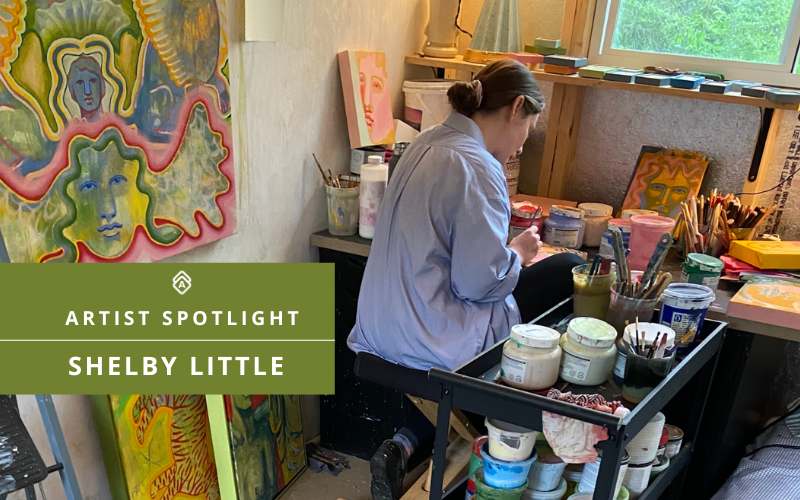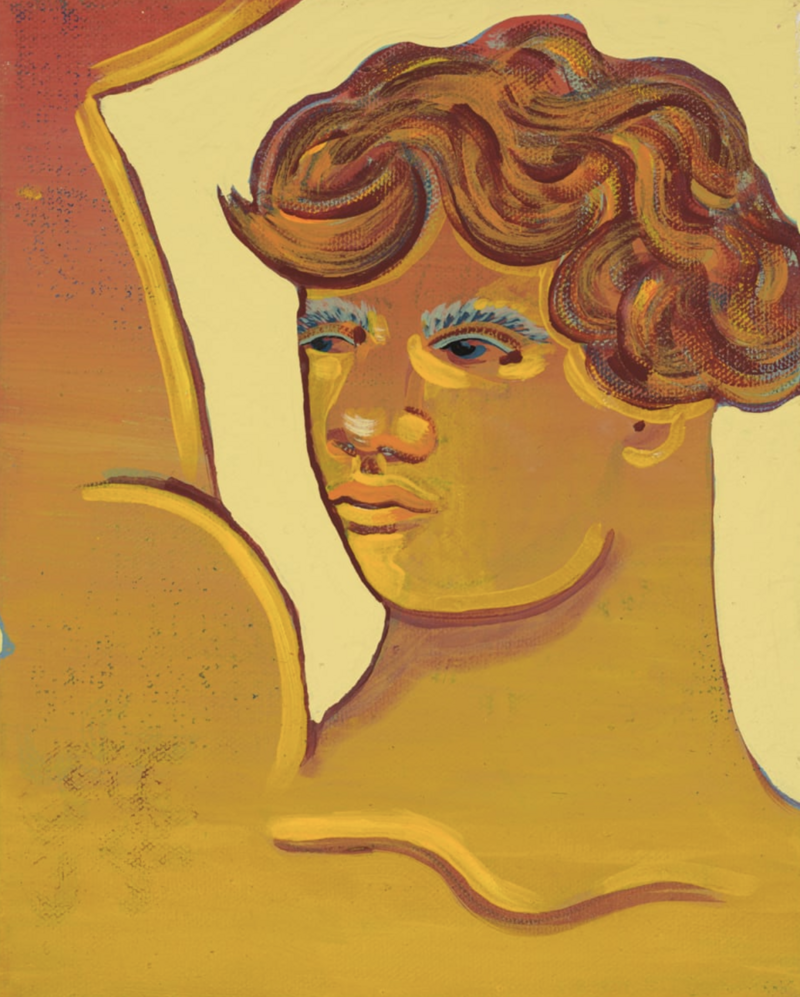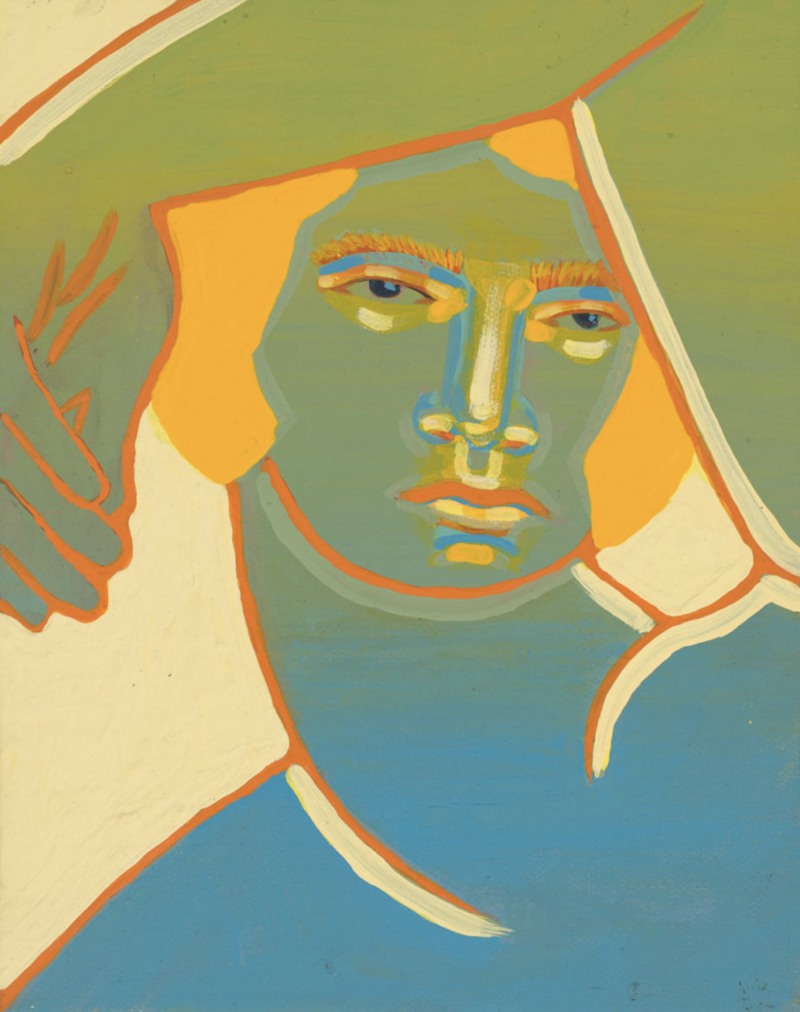“There is a hidden narrative that unfolds throughout my process.”
This week’s Featured Artist, Shelby Little, invites us into a mythic world of her own making—one where memory, mortality, and myth intertwine.
Shelby’s work feels suspended between timelines: inspired by Greco-Roman mythology and built from fragments of dreams, personal photos, and ancient references, her paintings create a dialogue between past and present. It’s a visual language that feels both familiar and mysterious—pulling viewers in with playful characters, then holding them in a space that’s quietly haunting.
Through each piece, Shelby explores the duality of life: joy and grief, chaos and order, the tangible and the spiritual. As she puts it, “I aim to create pieces that feel both ancient and contemporary.” And she does—layer by layer, character by character, as her imagined mythologies slowly reveal themselves.
Artwork Archive had the chance to chat with Shelby Little about her creative process, the inspiration behind her work, and how Artwork Archive has become her go-to tool.
You can see more of her work on Discovery and learn more about her art practice below:
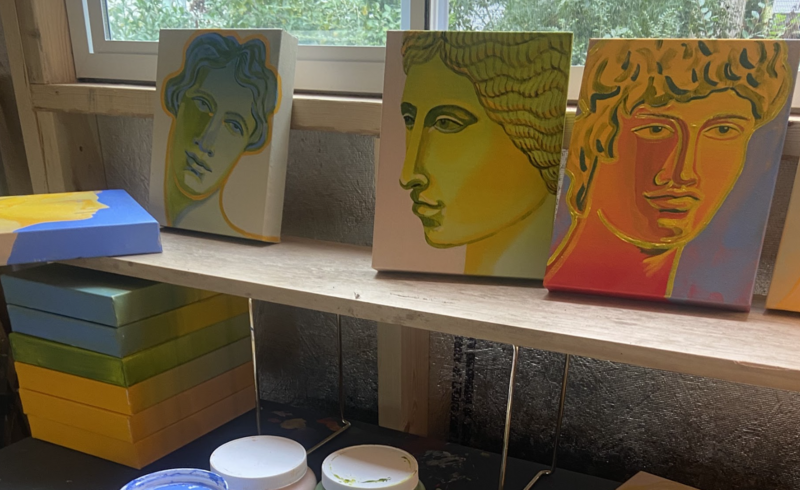
Each portrait carries a sense of history—and a place in Little's evolving archive of work. Photo courtesy of the artist
A Studio Built on Rotation, Rhythm, and Printed Inspiration
Shelby Little’s creative process starts long before paint even hits the canvas. It begins with gathering source material—pulled from books, found online, and captured through her own photography. But you won’t find her scrolling through references mid-session.
“I prefer to print out any imagery to have in the studio with me rather than looking at a screen,” she says.
Once she’s assembled her visual prompts, Shelby chooses a color palette and sets her workspace with intention: colors lined up within reach, multiple canvases prepped and waiting. She works on several pieces at once, moving from one to the next in a fluid rotation.
“I like to work on multiple paintings at one time with a singular color palette, rotating each painting every few minutes as I work,” she shares. “It’s difficult to know when a piece is complete—rotating them consistently helps me find the endpoint in a painting, rather than overworking a piece.”
It’s a process built on movement and intuition—one that allows her work to evolve with a sense of rhythm and restraint.
Myths With No Final Word
Much of Shelby’s work draws from the well of Greco-Roman mythology—as living stories open to reinterpretation.
“Greek and Roman myths are an endless pool of inspiration for me,” she says. “There are so many versions of the same tales. I love the idea that there’s no singular truth or correct telling. I like to think of my paintings as further re-tellings of the same myths, transforming them to fit my needs.”
In her hands, mythology becomes material—something to be stretched, reshaped, and made personal.
Shelby Little, Helios, 10 x 8 x 1.5 in
Where Time Bends and Candy-Coated Ghosts Appear
Shelby Little’s paintings are infused with a visual tension between the old and the new—what she calls a conversation across time. The cyclical nature of history shows up in her work through palettes that feel both modern and ancient, and characters that seem pulled from another world.
“By blending color palettes that are simultaneously contemporary and archaic with familiar ancient imagery, I aim to create a dialogue between the past and present,” the artist explains. “The characters in my portraits feel both familiar, strangely bright, and forcibly joyful—like candy-coated ghosts.”
This haunting vibrancy is part of what makes her work so compelling—each painting feels like a memory reimagined.
Make What You Want to See
You won’t find this creator chasing trends or crowd approval—here’s where she places her focus:
“Create what you want to see instead of what you think others want.”
It’s a small shift, but it can change everything. And while you're in the thick of trying to make a living from your work, it's easy to forget. But when things start to feel off—when your art doesn't quite feel like yours—it's often the first thing worth returning to.
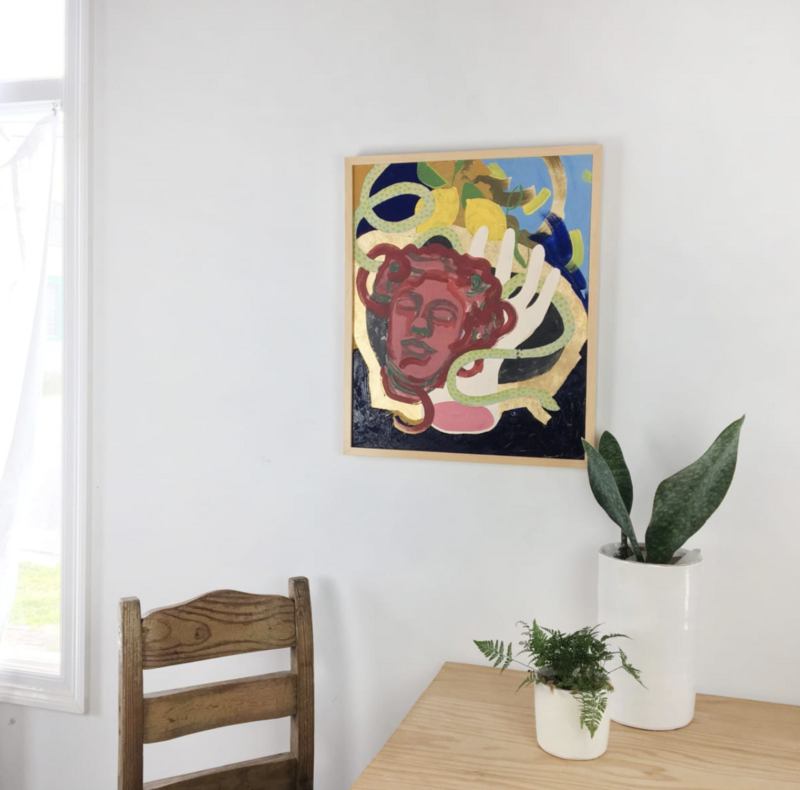
Shelby Little, Holding Onto What's Left, 24 x 18 x 2 in
Courage Over Perfection
One of the biggest turning points for our Featured Artist came when she stopped waiting for the work to feel flawless.
When asked about the hardest part of being a professional artist, Shelby Little put it plainly: “Being brave enough to share your work in the first place.”
“Put whatever you have out there,” she encourages. “Don’t wait to make something perfect.”
Her advice rings true for artists at every stage: start before you feel ready.
The Moment Shelby Little Needed a System
Shelby remembers the exact moment her art career outgrew the mental spreadsheet system.
“When I was still living in New Orleans, I started to place work in multiple galleries and started selling prints in galleries, shops, and my own studio,” she recalls. “It became difficult to keep track of what was where.
"Artwork Archive has made all of that very simple to track.”
As her business expanded, she needed a tool that could keep pace. But Artwork Archive is not just something artists need once they’ve “made it” or hit a certain level. Having an inventory system from the very beginning can shape how your career grows.
Set Yourself Up Like the Professional Artist You Already Are:
When you know where everything is, what’s available, what’s sold, and who owns what, you're not playing into the 'scattered, starving artist' trope.
You’re making decisions with confidence. You’re building good habits early on. And when the opportunities start stacking up—whether it’s a group show, a studio visit, or your first collector—you'll be ready.
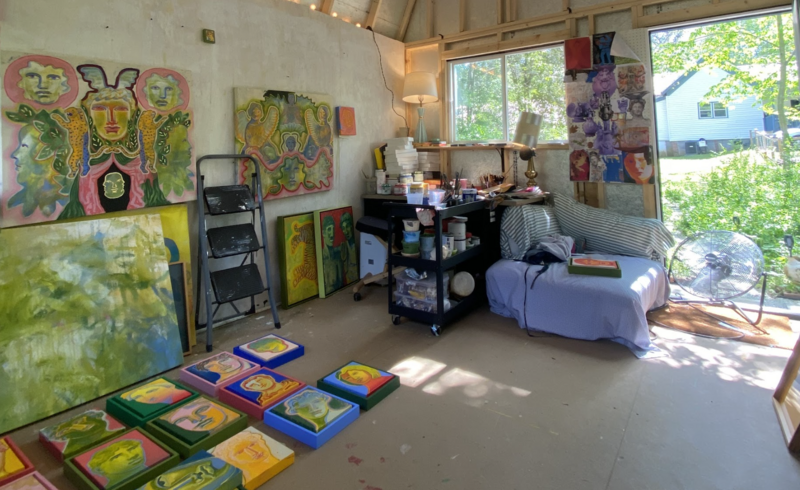
Amid the color and movement of Shelby Little’s studio, Artwork Archive helps her stay organized behind the scenes. Photo courtesy of the artist
What Helps This Artist Stay Focused on Her Studio Practice
These days, a few tools in Artwork Archive have become part of Shelby's weekly rhythm. They help her keep track without getting pulled away from the creative part of her practice.
Here’s what she leans on most:
-
Contacts Feature – "to keep a log of all the past features I've sold to each person."
-
Runs & Reproductions –"to stay on track with all my prints."
-
Private Rooms – "to curate a list of only relevant and available pieces a particular person may be interested in.”
They’re small things—but together, they make a big difference in how she keeps her business side flowing without letting it crowd her creative headspace.
A Few More Artist-Favorite Features to Make Life Easier:
Shelby Little uses Contacts, Runs & Reproductions, and Private Rooms to keep her studio and business organized—and she's in good company. Artists across all disciplines have been finding ways to make their admin side less overwhelming with a few simple tools. Here are some other features they swear by:
-
Exhibition Tracking – to remember where your pieces are showing and when they need to be dropped off or picked up.
-
Location Records – to keep tabs on every artwork's current home—your studio, a gallery, or a an exhibition.
-
Invoices – to send professional, polished invoices in minutes (and keep your records tidy).
-
Public Profile – to showcase available work in a clean, searchable format—boosting your online presence.
Want to see what might support your own process? Take a look around and explore what other artists are using to keep things running smoothly.
One Last Word for the Long Haul
Shelby Little has been through the early-career uncertainty, the full calendars, the slow stretches. So when asked what advice she’d pass along to artists just starting out, her answer is simple:
“It’s a long game. There are seasons of productivity, seasons of exhibitions, and seasons of rest. Be gentle with yourself.”
That kind of pacing can be hard to hold onto when you’re just getting going—but it's worth remembering. Your career doesn’t have to happen all at once, and you don’t have to sprint through every season.
Let your process unfold the way it needs to, and give yourself space to grow into the artist you’re becoming.
